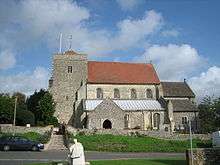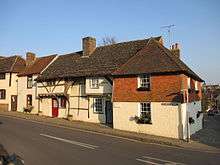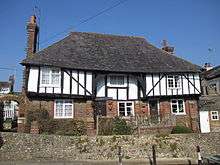Steyning
Steyning (/ˈstɛnɪŋ/ STEN-ing) is a small rural town and civil parish in the Horsham District of West Sussex, England. It is located at the north end of the River Adur gap in the South Downs, four miles (6.4 km) north of Shoreham-by-Sea.
| Steyning | |
|---|---|
 High Street, Steyning town centre | |
 Steyning Location within West Sussex | |
| Area | 15.74 km2 (6.08 sq mi) [2] |
| Population | 5,812 [2] 2001 Census 5,990 (Census 2011)[3] |
| • Density | 369/km2 (960/sq mi) |
| OS grid reference | TQ177110 |
| • London | 43 miles (69 km) NNE |
| Civil parish |
|
| District |
|
| Shire county | |
| Region | |
| Country | England |
| Sovereign state | United Kingdom |
| Post town | STEYNING |
| Postcode district | BN44 |
| Dialling code | 01903 |
| Police | Sussex |
| Fire | West Sussex |
| Ambulance | South East Coast |
| UK Parliament | |
The smaller villages of Bramber and Upper Beeding constitute, with Steyning, a built-up area at this crossing-point of the river.
Demography
The parish has a land area of 1,574 hectares (3,890 acres). In the 2001 census 5,812 people lived in 2,530 households, of whom 2,747 were economically active.
History
Saxon

Steyning has existed since Anglo-Saxon times. Legend has it that St Cuthman built a church, at one time dedicated to him, later to St Andrew, and now jointly to St Andrew and St Cuthman, where he stopped after carrying his mother in a wheelbarrow. Several of the signs that can be seen on entering Steyning bear an image of his feat. King Alfred the Great's father, Æthelwulf of Wessex, was originally buried in that church, before being transferred to Winchester – a Saxon grave slab (possibly his) remains in the church porch.
Norman
To thank his Norman protectors for refuge during his exile, Edward the Confessor granted his royal minster church in Steyning, with its large and wealthy manor lands, to the Abbey Church of the Holy Trinity at Fécamp, to take effect after the death of Aelfwine, the Bishop of Winchester, who had charge of Steyning. The bishop died in 1047 and ecclesiastical jurisdiction then passed directly to the Pope. (In the same way, Fécamp Abbey itself answered to no Norman bishop, only to the Pope.) This was confirmed in a charter by William. Confirming the gift of Steyning, made by Edward the Confessor, this charter acquitted the grantees of all earthly service and subjection to barons, princes and others, and gave them all royal liberties, custom and justice over all matters arising in their land, and threatened any who should infringe these liberties with an amercement of £100 of gold.[4] This was an addition to the nearby port with land around Rye, Winchelsea and Hastings, already given to the same Abbey by King Cnut, to honour a promise made by his wife Emma of Normandy's first husband King Aethelred. By then Steyning was already a thriving and important port with a market, a royal mint, the church founded by St Cuthman and one other church, as Domesday Book relates 60 years later. Godwin, Earl of Wessex expelled the Norman monks in 1052 and seized Steyning for himself, and his son Harold decided to keep it upon his accession. This made commercial and strategic sense as Harold did not want a Norman toehold in a potential invasion port, but William responded by swearing on a knife before setting out for England to recover it for the monks:
- Of the land of Steyning [county of Sussex]; the Duke gave seisin to the Church by the token of a knife, before he went to England; the grant to take effect if God should give him victory in England.
- Witnesses: Aymeri the vicomte; Richard fitzGilbert; Pons.[5]

This gained him a ship from Fécamp and, upon his victory at Hastings, he honoured his promise and returned it to the monks. However, its strategic importance made William place William de Braose in a new castle at nearby Bramber, who began a vigorous boundary dispute and power tussle with the monks, William's settlement having lacked definite terms in the first place. Domesday Book, completed in 1086, brought this to a head. It found that de Braose had built a bridge at Bramber and demanded tolls from ships travelling further along the river to the port at Steyning. The monks challenged Bramber's right to bury its parishioners in the churchyard at William de Braose's new church of St Nicholas, and demanded its burial fees, despite it being built to serve the castle not the town. The monks produced forged documents to defend their position and were unhappy with the failure of their claim on Hastings.[6] In 1086 the king called his sons, barons and bishops to court (the last time an English king presided personally, with his full court, to decide a matter of law) to settle this. It took a full day, and the Abbey won over the court, forcing de Braose to curtail his bridge tolls, give up various encroachments onto the abbey's lands[7] and organise a mass exhumation and transfer of all Bramber's dead to the churchyard of Saint Cuthman's Church in Steyning.
Mid to Late Medieval

Even the 1086 judgment did not settle the Steyning versus Bramber dispute once and for all; it continued for centuries afterwards, exacerbated by the Lord of Bramber founding his own religious establishments in his neighbouring parish. Meanwhile, in the 14th century, the River Adur began to silt up and the town's use as a port became difficult leading to a loss of trade and population. The monks of Fécamp Abbey retained control of Steyning until the 15th century, and re-dedicated the church of St Cuthman to St Andrew in the 13th century.
Steyning began returning two members of parliament from 1278 and as a rotten borough made up of a depopulated port became similar to Dunwich until the Reform Act 1832.
17th century
In 1614, William Holland, Alderman of Chichester founded and endowed Steyning Grammar School.[8]
19th century

The Steyning Line railway from London to Shoreham arrived in Steyning in 1861 and a station was opened to serve the town, see the black line and station in the map displayed.
Steyning Town Hall, (currently an estate agents) at 38 High Street, was built in 1886.
The legendary Irish politician Charles Stewart Parnell married 'Kitty' O'Shea (niece of Lord Hatherley) here in 1891, the culmination of an adulterous affair that saw his fall from power, catastrophically dividing Irish politics.
Besides much agriculture, brewing, a tannery (Tanyard Lane) and to a small extent brickmaking, more than 25 men were employed in the sheep related trade as fellmongers, more than four were parchment makers, five were millers and there was a surgeon, an oil painter, James M. Burfield, and a watch maker in the town during the 1881 census.[9]
The railway remained in service for over a century, closing in 1966 as result of the Beeching Axe. The route of the railway line has since been converted into a footpath and cycleway known as the Downs Link. The nearest railway station to the town today is Shoreham-by-Sea
Modern town
In Steyning there is access to a variety of facilities including four public houses, many boutique shops, cafes and four estate agents. There is a leisure centre, which was built with National Lottery funding. It has a modern health centre, a public library and the Steyning Museum.
A spring fair is held on the Spring bank holiday (the last Monday in May)
The Monarch's Way long-distance footpath skirts the southern end of the town.
Schools
The town is home to Steyning Grammar School, now a comprehensive school of 2,500 pupils founded in the Stuart period, see above, with a sixth form comprising over 400 pupils. The school has a catchment area that extends as far as Dial Post and sometimes Worthing. And it also has a primary school (400 pupils) and a pre-school.
Towers Convent School, a Catholic independent day and boarding school, is located in nearby Upper Beeding. It educates girls from pre-prep to age 16 and boys up to age 8.
Steyning Festival
The Steyning Festival was founded in 2006 by Ann Poupard, a resident of the town. The event is now biennial and runs for two weeks at the end of May/start of June. It features theatre, music, literature, talks, walks, community events and more.
In 2009, the Steyning Festival was awarded a lottery grant to bring international artist and psychogeographer Chris Dooks to Steyning for a month-long residency, resulting in a free MP3 tour.
Sport and leisure
There is a long established cricket club near the police station.[10] Steyning has a non-league football club called Steyning Town Community Football Club, who play at the Shooting Field. The town also has its own leisure centre.
Steyning Athletic Club, established in 1951, offers a variety of sports to members - including Running, Swimming, Cycling, Race walking, Circuits/Fitness and Triathlon. Annual Club events include the Roundhill Romp (10k running race that is part of the Sussex Fun Run League) and the Steyning Stinger (Full Marathon and Half Marathon on the South Downs).
Nightlife
Steyning has four pubs (the Star Inn, the Chequer Inn, the White Horse and the Norfolk Arms), as well as a number of restaurants.
Notable residents
- Christopher Rawson Penfold, who founded Penfolds, one of Australia's greatest wine growing businesses, was born on 2 August 1811, son of the vicar of Steyning, John Penfold
- Peter Carter-Ruck, founder of Carter-Ruck Solicitors, was born in the town in 1914
- E. M. Delafield, author, was born and grew up in Steyning
- Julia Donaldson, author, lives in Steyning
- Sally Gunnell, former British athlete and gold-medal winner in the 1992 Summer Olympic Games
- Bernard Holden, railway engineer and president of the Bluebell Railway lived in the Station Master's House from 1912 and attended Steyning Grammar School in the 1920s
- John Ireland, composer
- Victor Benjamin Neuburg occultist and poet, proprietor of the Vine Press
- Elizabeth Norton, historian and author, grew up in Steyning and was educated at Steyning Grammar School
- Laurence Olivier, the actor, had a home in Ashurst, near Steyning, where he died in 1989 at the age of 82
- Richard Raphael, cricketer
- W. B. Yeats, the Irish poet, stayed at the Chantry House in his later years with his mistress Edith Shackleton Heald; she spent her last years there with the artist Gluck.
References
- Steyning Registration District (UKBMD)
- "2001 Census: West Sussex – Population by Parish" (PDF). West Sussex County Council. Archived from the original (PDF) on 8 June 2011. Retrieved 12 April 2009.
- "Civil Parish population 2011". Neighbourhood Statistics. Office for National Statistics. Retrieved 3 October 2016.
- From: Regesta Regum Anglo-Normannorum 1066–1154 Volume I, edited by H W C Davis (Oxford, 1913)
- Regesta Regum Anglo-Normannorum 1066–1154 Volume I, edited by H W C Davis (Oxford, 1913)
- The monks claimed the same freedoms and land tenure in Hastings as King Edward had given them at Steyning. Though on a technicality William was bound to uphold all aspects of the status quo before Edward's death, the monks had already been expelled 10 years before that death. King William wanted to hold Hastings for himself for strategic reasons and ignored the problem until 1085, when he confirmed their Steyning claims but swapped the Hastings claim for land in Bury (near Pulborough).
- Including a rabbit warren, a park, eighteen burgage plots, a causeway and a channel to fill his moat
- http://steyningmuseum.org.uk/brotherhood.htm
- http://www.familysearch.org/Eng/Search/frameset_search.asp?PAGE=census/search_census.asp 1881 Census from the Church of Jesus Christ of Latter-Day Saints
- "County Times". West Sussex County Times. Retrieved 29 September 2015.
- 'Steyning', A History of the County of Sussex: Volume VI Part 1: Bramber Rape (Southern Part) (1980), pp. 220–26. URL: . Date accessed: 8 July 2009.
- Horsham District Council – Parish Population Estimates
External links
| Wikimedia Commons has media related to Steyning. |